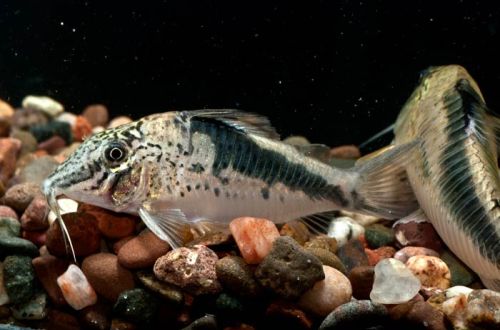
Aguaruna
Muscular catfish or Aguaruna, scientific name Aguarunichthys torosus, belongs to the family Pimelodidae (Pimelod or Flathead catfishes). The second name of this species is given in honor of the tribe of Indians living in the Peruvian jungle on the Marañon River, where researchers first discovered this catfish. Compared to other carnivorous predatory fish, it is quite easy to keep under certain conditions, however, it is not recommended for beginner aquarists.

Contents
Habitat
It originates from South America from the Marañon River basin in the upper Amazon basin, which flows mainly through the territory of Peru and Ecuador. Inhabits various biotopes – fast rivers flowing down from the mountains, as well as floodplain lakes and backwaters along the main riverbed.
Brief information:
- The volume of the aquarium – from 500 liters.
- Temperature – 22-27°C
- Value pH — 5.8–7.2
- Water hardness – 5–15 dGH
- Substrate type – any
- Lighting – any
- Brackish water – no
- Water movement – light or moderate
- The size of the fish is up to 34 cm.
- Diet – sinking food for carnivorous species
- Temperament – inhospitable
- Content single
Description
Adult individuals reach a length of up to 34 cm. Catfish has an elongated massive body with a small flat head with six sensitive antennae. The fins are not big. The coloration is light with numerous dark specks.
Food
Predator, in nature feeds on other fish. In aquariums, adapts to alternative foods. You can serve specialized food for carnivorous species, earthworms, shrimp meat, mussels, strips of white fish. Feed 2-3 times a week.
Maintenance and care, arrangement of the aquarium
The optimal size of the aquarium for one catfish starts from 500 liters. Decoration does not really matter when keeping a Muscular catfish, the main thing is to provide a lot of free space. It is much more important to ensure high water quality within acceptable ranges of temperatures and values of hydrochemical parameters. It is impossible to allow the accumulation of organic waste (food residues and excrement), which, due to the peculiarities of the diet, pollute the water very much. The stability of the habitat and the ecological balance inside the aquarium depends on the regularity of the mandatory maintenance procedures and the smooth operation of the equipment, primarily the filtration system.
Behavior and Compatibility
Not a very friendly species, in conditions of lack of space, it will compete with relatives and other large bottom fish for territory and food resources. The smaller the space, the more aggressive the behavior becomes. Any small fish will be potential prey, so they should be excluded.
Fish diseases
The cause of most diseases is unsuitable conditions of detention. A stable habitat will be the key to successful keeping. In the event of symptoms of the disease, first of all, the quality of the water should be checked and, if deviations are found, measures should be taken to correct the situation. If symptoms persist or even worsen, medical treatment will be required. Read more about symptoms and treatments in the Aquarium Fish Diseases section.





